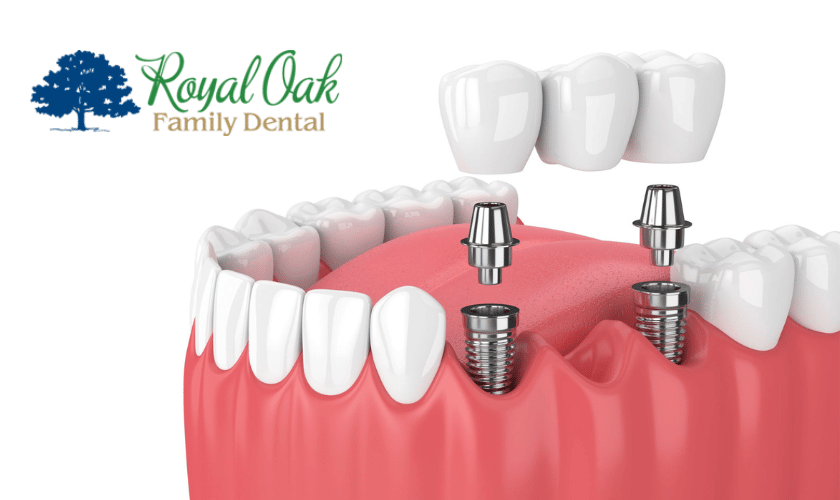
An implant bridge is a dental prosthetic used to replace one or more missing teeth. It is supported by dental implants, which are titanium posts that are surgically placed in the jawbone. The implant bridge is attached to the implants and looks and functions like a natural tooth.
If you are missing one or more teeth, an implant bridge may be an option for you. This type of dental prosthetic can restore your smile and restore your ability to chew and speak properly.
To be a candidate for an implant bridge, you must have healthy gums and enough bone in your jaw to support the implants. You must also be committed to maintaining good oral hygiene and visiting your dentist regularly for checkups and cleanings.
If you think an implant bridge may be right for you, schedule a consultation with your dentist. He or she will examine your mouth, take X-rays, and determine if you are a good candidate for this type of dental prosthetic.
A good candidate for an implant bridge treatment is someone who has lost one or more teeth and wants to restore their smile. The best candidates have healthy gums and enough bone in their jaw to support the implants. If you are missing all your teeth, an implant-supported denture may be a better option.
If you are considering an implant bridge, you must consult a qualified dental professional to discuss your specific situation. The procedure for getting an implant bridge will vary depending on individual circumstances. However, the general process typically involves the following steps:
1. Consultation with a dental professional: During this consultation, your dentist will assess your individual needs and determine whether an implant bridge is the best treatment option for you.
2. Placement of dental implants: Once it has been determined that you are a good candidate for an implant bridge, your dentist will surgically place one or more implants in your jawbone. This step is typically done under local anesthesia.
3. Healing and osseointegration: After the implants have been placed, you will need to allow time for them to fuse with your jawbone (a process called osseointegration). This usually takes several months. During this time, you may be fitted with a temporary denture or bridge to help improve your appearance and function.
4. Attachment of the permanent bridge: Once the implants have fully integrated with your jawbone, your dentist will attach the permanent implant bridge. This typically takes place over two appointments.
An implant bridge is a great option for those who are missing one or more teeth and are looking for a way to replace them. There are many benefits to choosing an implant bridge, including:
1. An implant bridge can give you back your smile.
2. An implant bridge can help you eat and speak properly.
3. An implant bridge can improve your overall oral health.
4. An implant bridge can last a lifetime with proper care.
If you are considering an implant bridge, be sure to talk to your dentist about whether or not it is the right option for you.
An implant bridge is a great way to replace missing teeth and give you a beautiful, natural-looking smile. But like all dental implants, an implant bridge needs to be cared for properly to ensure long-term success. Here are some tips for caring for your new implant bridge:
Brush and floss regularly: Like with your natural teeth, brushing and flossing your implant bridge daily is important. This will help remove plaque and bacteria from around the implants and keep your gums healthy.
See your dentist regularly: Be sure to see your dentist at least twice a year for checkups and cleanings. They will be able to check on your implants' health and ensure they are still in good condition.
Avoid hard foods: Be careful with nuts and candy that can damage your implant bridge. Stick to softer foods until you get used to eating with your new implants.
With proper care, your implant bridge can last for many years. So if you're considering this option for replacing missing teeth, talk to your dentist about what you need to do to keep your new smile looking great!
We hope this article has helped shed some light on the process of getting an implant bridge and whether or not you may be a suitable candidate. If you're considering getting an implant bridge, it's important to speak with your dentist first and get all the facts before making any decisions. Your dentist can assess your situation and help guide you through the process if implants are right for you.
A1: An implant bridge is a type of dental restoration that uses dental implants to replace missing teeth. The bridge is made up of two or more crowns that are attached to adjacent teeth or dental implants and is used to fill in the gap created by missing teeth.
A2: The amount of time it takes to get an implant bridge will vary depending on the patient's individual circumstances. Generally, the process takes several months, including initial consultations, preparation, implant placement, and bridge placement.
A3: Yes, an implant bridge is a permanent solution for missing teeth. The implants fuse with the jawbone to provide a secure foundation for the bridge, making it a long-lasting solution.